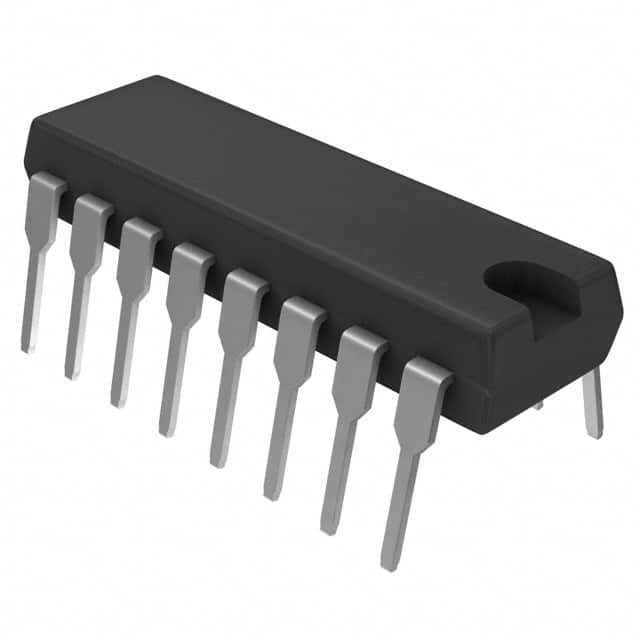CD74HCT283EG4
Product Overview
- Category: Integrated Circuit
- Use: Arithmetic Logic Unit (ALU)
- Characteristics: High-speed, low-power consumption
- Package: 16-pin SOIC (Small Outline Integrated Circuit)
- Essence: Performs binary addition and subtraction operations
- Packaging/Quantity: Tape and reel, 2500 units per reel
Specifications
- Supply Voltage Range: 2V to 6V
- Operating Temperature Range: -40°C to +85°C
- Logic Family: HCT
- Number of Inputs: 8
- Number of Outputs: 4
- Propagation Delay: 14 ns (typical)
Detailed Pin Configuration
- A0: Input A0
- B0: Input B0
- A1: Input A1
- B1: Input B1
- A2: Input A2
- B2: Input B2
- Carry-In: Input Carry-In
- GND: Ground
- Sum0: Output Sum0
- Carry-Out: Output Carry-Out
- Sum1: Output Sum1
- A3: Input A3
- B3: Input B3
- VCC: Power Supply
- BCD: Binary-Coded Decimal (BCD) Input
- A4: Input A4
Functional Features
- Performs 4-bit binary addition and subtraction operations
- Supports carry-in and carry-out functionality
- Provides binary-coded decimal (BCD) input capability
- High-speed operation with low power consumption
- Compatible with TTL (Transistor-Transistor Logic) inputs
Advantages and Disadvantages
Advantages: - High-speed performance enables quick arithmetic calculations - Low power consumption reduces energy usage - Compact package size allows for space-efficient designs - Compatibility with TTL inputs ensures easy integration into existing systems
Disadvantages: - Limited to 4-bit operations, may not be suitable for complex calculations - Requires external components for more advanced arithmetic functions - Higher cost compared to basic logic gates due to integrated ALU functionality
Working Principles
The CD74HCT283EG4 is an Arithmetic Logic Unit (ALU) integrated circuit that performs 4-bit binary addition and subtraction operations. It utilizes a combination of logic gates and flip-flops to process the input signals and generate the corresponding output results. The carry-in and carry-out pins enable cascading multiple ALUs for larger bit-width calculations. The BCD input capability allows direct conversion between binary and decimal representations.
Detailed Application Field Plans
Microcontrollers: The CD74HCT283EG4 can be used in microcontroller-based systems to perform arithmetic calculations, such as adding or subtracting values from sensors or user inputs.
Digital Signal Processing: In digital signal processing applications, this ALU can be utilized for performing mathematical operations on audio, video, or other types of signals.
Computer Architecture: The ALU is a fundamental component of computer processors, and the CD74HCT283EG4 can be employed in designing simple 4-bit processors or as a building block for more complex architectures.
Educational Purposes: Due to its simplicity and ease of use, this ALU can be used in educational settings to teach basic digital logic and arithmetic concepts.
Detailed and Complete Alternative Models
- SN74LS283: Similar 4-bit binary adder/subtractor IC with TTL logic family.
- CD74HC283E: 4-bit high-speed CMOS adder/subtractor IC with different package options.
- MC14581B: 4-bit parallel binary adder with carry-in and carry-out functionality.
(Note: The above list is not exhaustive and there are several other alternative models available in the market.)
This entry provides an overview of the CD74HCT283EG4, a 4-bit binary adder/subtractor integrated circuit. It includes information about its category, use, characteristics, package, essence, packaging/quantity, specifications, pin configuration, functional features, advantages and disadvantages, working principles, detailed application field plans, and alternative models.
قم بإدراج 10 أسئلة وإجابات شائعة تتعلق بتطبيق CD74HCT283EG4 في الحلول التقنية
Sure! Here are 10 common questions and answers related to the application of CD74HCT283EG4 in technical solutions:
Q: What is CD74HCT283EG4? A: CD74HCT283EG4 is a high-speed CMOS logic device, specifically a 4-bit binary full adder with fast carry.
Q: What are the key features of CD74HCT283EG4? A: Some key features include low power consumption, high-speed operation, compatibility with TTL inputs, and wide operating voltage range.
Q: How can CD74HCT283EG4 be used in technical solutions? A: CD74HCT283EG4 can be used in various applications such as arithmetic operations, data processing, digital signal processing, and control systems.
Q: What is the maximum operating frequency of CD74HCT283EG4? A: The maximum operating frequency of CD74HCT283EG4 is typically around 50 MHz.
Q: Can CD74HCT283EG4 handle multiple supply voltages? A: No, CD74HCT283EG4 operates on a single supply voltage, typically between 4.5V and 5.5V.
Q: Does CD74HCT283EG4 have built-in protection against electrostatic discharge (ESD)? A: Yes, CD74HCT283EG4 has built-in ESD protection, which helps safeguard the device from damage during handling and assembly.
Q: What is the package type for CD74HCT283EG4? A: CD74HCT283EG4 is available in various package types, such as SOIC (Small Outline Integrated Circuit) and TSSOP (Thin Shrink Small Outline Package).
Q: Can CD74HCT283EG4 be used in both digital and analog circuits? A: No, CD74HCT283EG4 is specifically designed for digital logic applications and may not be suitable for analog circuits.
Q: Are there any specific precautions to consider when using CD74HCT283EG4? A: It is important to follow the recommended operating conditions, avoid exceeding the maximum ratings, and handle the device properly to prevent ESD damage.
Q: Where can I find more information about CD74HCT283EG4? A: You can refer to the datasheet provided by the manufacturer or visit their official website for detailed information on CD74HCT283EG4's specifications, application notes, and usage guidelines.
Please note that the answers provided here are general and may vary depending on the specific requirements and use cases.


